Management of the ewe in late pregnancy affects lamb weight and vigour at birth, and colostrum production by the ewe, all of which influence labour requirement at lambing and flock profitability.
Each additional 0.1 lamb reared per ewe joined is worth approximately €10/ewe.
This article summarises results from the studies at Athenry on the effects of the type of nutrition offered to ewes in late pregnancy on ewe and lamb performance.
Digestibility (DMD) is the most important indicator of the feed value of grass silage when offered to ewes. At farm level, DMD of grass silages can vary from 52% to 82%; the average DMD of silage produced in Ireland is 70%.
Consequently, when developing a nutritional plan for housed ewes in late pregnancy it is essential to know the feed value of the silage being offered.
A number of studies were undertaken at Athenry to evaluate the effect of silage digestibility on the performance of pregnant ewes, and that of their progeny.
Increasing silage DMD increased ewe liveweight and body condition score (BCS) at lambing and increased lamb birth and weaning weights. Each five percentage-point increase in silage DMD increases ewe weight post-lambing by 6.5kg and lamb birth weight by 0.25kg.
An alternative way to evaluate silage feed value is to determine how much concentrate is required to yield lambs of a similar birth weight.
At Athenry, ewes offered a high feed value (high DMD) grass silage and supplemented with 5kg concentrate (soya bean meal plus minerals and vitamins) during late pregnancy produced lambs that were heavier than the lambs from equivalent ewes offered a medium feed value silage supplemented with 20kg concentrate.
Therefore, the high feed-value grass silage enabled concentrate supplementation to be reduced by at least 75 %.
Silage feed value and concentrate
The effects of concentrate feed level and silage feed value (DMD) on lamb birth weight and BCS at lambing are presented in Table 1.
Note for ewes offered silage with 70 % DMD, increasing concentrate feed level allowance above 25kg yielded no real gain in lamb birth weight but the ewes were clearly fatter (higher BCS); for ewes on 75% DMD silage – increasing concentrate allowances above 15kg yielded a minimum change in lamb birth weight.
Therefore, the increased energy intake from feeding excess concentrate to ewes during late pregnancy is converted to body fat.
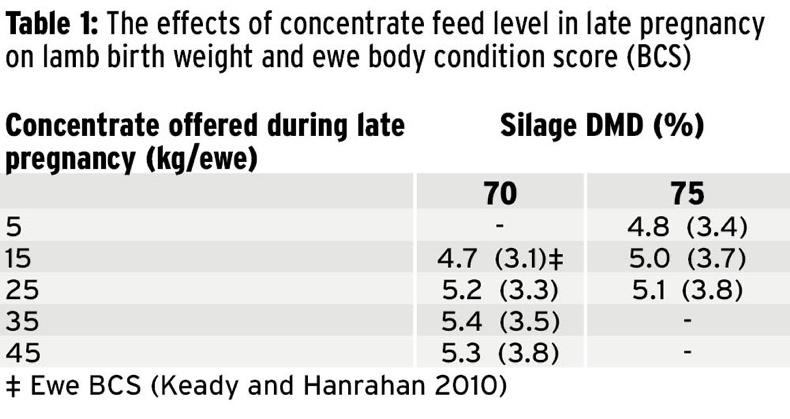
Soya bean meal as the concentrate
Two studies have been undertaken at Athenry (Table 2) to evaluate the effects of replacing concentrate with low levels of soya bean meal (5kg) during late pregnancy in ewes offered high feed value grass silage. Increasing concentrate feed level from 15kg to 25kg during late pregnancy had little effect on lamb birth or weaning weight.
Reducing supplementation from 15kg concentrate to 5kg soya bean meal reduced lamb birth weight by 0.2kg, weaning weight by 0.8kg, and supplement cost by €1.45 but increased lamb age at slaughter by approximately one week, silage requirements by 9 % and silage cost by approximately €0.80.
The difference between reduced concentrate cost and increased silage cost is small. With high feed value grass silage it may be more prudent to offer concentrate during late pregnancy rather than supplement with lower levels of soya bean meal.
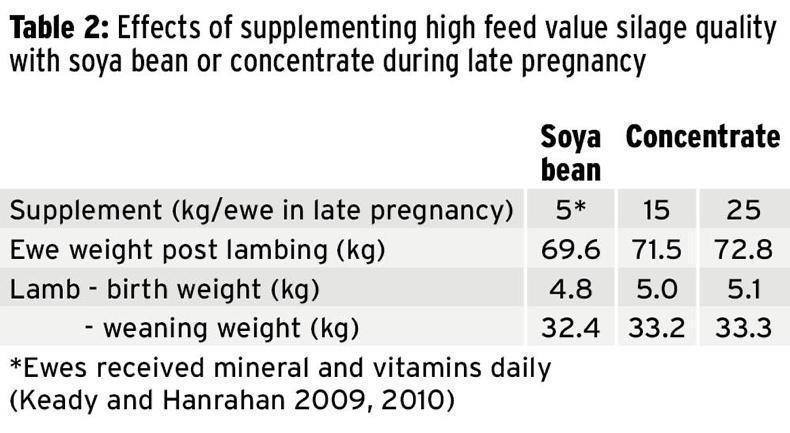
Level of concentrate to offer
The effects of silage feed value on the concentrate requirement of twin-bearing ewes in late pregnancy are presented in Table 5.
It is assumed that the silage is offered using good feeding management, ie ewes have access to fresh silage 24 hours daily and that any silage residue is removed twice weekly.
The main factor influencing concentrate requirement during late pregnancy is silage DMD. For example, for silages at 79% and 64% DMD an additional 3kg and 10kg concentrate, respectively are required for long-chop silages, compared with precision-chop-silages.
The concentrate requirements per ewe presented in Table 3 can be reduced by 5kg in the case of single-bearing ewes, while concentrate supplementation should be increased by 8kg for ewes carrying triplets.
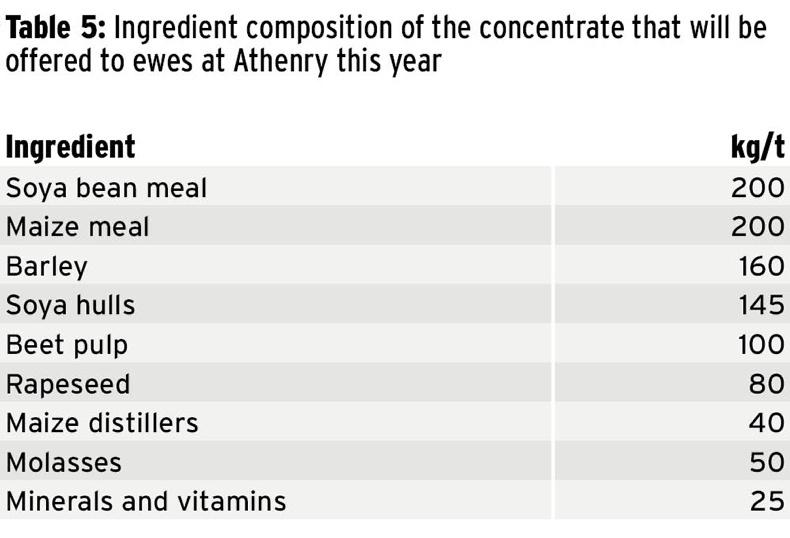
Concentrate protein content
For prolific flocks, the concentrate should be formulated to contain 19% crude protein as the grass silage on many sheep farms has a low protein concentration.
Some personnel within the industry suggest formulating low and high protein concentrates for feeding to ewes during weeks six to four prior to lambing and weeks three to lambing, respectively.
However, considering the size of most sheep flocks in Ireland and the fact that ewes require low levels of concentrate during the first two to three weeks of supplementation, together with the low protein concentration of grass silage on most sheep farms the savings from using two different concentrates is, at best, marginal.
For example, while relative to a 19% crude protein concentrate, the cost of formulating a 14% crude protein concentrate is lower by approximately €25/t. This equates to only 0.5c and 1c per ewe daily when ewes are offered 0.2kg and 0.4kg/day during the first few weeks of supplementation.
For every 100 ewes in a flock one tonne of concentrate will last for 50 and 25 days, respectively, when ewes receive a daily concentrate allowance of 0.2kg and 0.4kg/head.
For most farms there is no benefit to animal production, logistics or financial outcome from offering a low protein concentrate during the first weeks of concentrate supplementation.
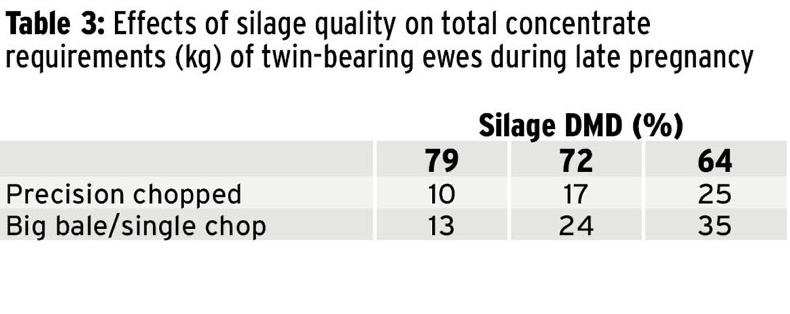
Protein source
The effects of concentrate protein source offered during late pregnancy on the performance of ewes and their progeny were evaluated at Athenry.
Two concentrates were formulated to have the same metabolisable energy and protein concentrations. The protein sources in the concentrates were either soya bean meal or a mixture of by-products (rapeseed, maize distillers and maize gluten).
Lambs born to ewes that had been offered the soya bean-based concentrate were 0.3kg and 0.9kg heavier at birth and weaning, respectively.
The increased weight of lambs at weaning from ewes offered the soyabean-based concentrate in late pregnancy (extra cost ~ €0.60/ewe) is similar to the response obtained from offering each lamb 6kg of creep concentrate until weaning (cost ~ €3.50/ewe per set of twins).
Therefore, it is more cost-effective to offer concentrate formulated with good ingredients (eg soya, cereals, pulps) to ewes in late pregnancy than supplement lambs to increase lamb weaning weight.
The ingredient composition of the concentrate that I formulated for ewes during late pregnancy at Athenry is presented in Table 5.
The concentrate was formulated to contain 19% protein using good protein (soya, rapeseed), energy (maize, barley) and fibre (beet pulp, soya hulls) sources.
Soya bean meal should form the main protein source for concentrates offered to ewes during late pregnancy.
When offering similar levels of concentrate to ewes during late pregnancy as is offered at Athenry, a reduction in concentrate price of €20/t equates to a saving equivalent of only 44c/ewe.
Therefore, when purchasing concentrate, it is very important to be aware of its ingredient composition rather than basing the decision on which concentrate to purchase solely on price alone.
Concentrate feeding management
To optimise the use of concentrate ewes should be grouped according to predicted litter size (based on ultrasonic scanning) and expected lambing date (mating date – raddle colour).
As lamb weight increases by 70% during the last six weeks of pregnancy, the demand for nutrients increases substantially. Consequently, supplementation should be stepped up weekly over the period immediately prior to lambing. The objective is to produce lambs at the optimum birth weight (that will not require assistance during delivery), and ewes with adequate supplies of colostrum.
The feed schedules required to deliver different concentrate feed levels, varying from 5kg to 45kg per ewe in late pregnancy, are given in Table 4.
During the week prior to lambing ewes receive up to 1kg daily, clearly illustrating the benefits of penning ewes according to expected lambing date, as well as expected litter size.
For example, for each extra week ewes are on the high level of concentrate supplementation they would consume 7 kg concentrate, dramatically increasing concentrate usage and cost (€2/ewe), and potential assistance (labour) required at lambing.
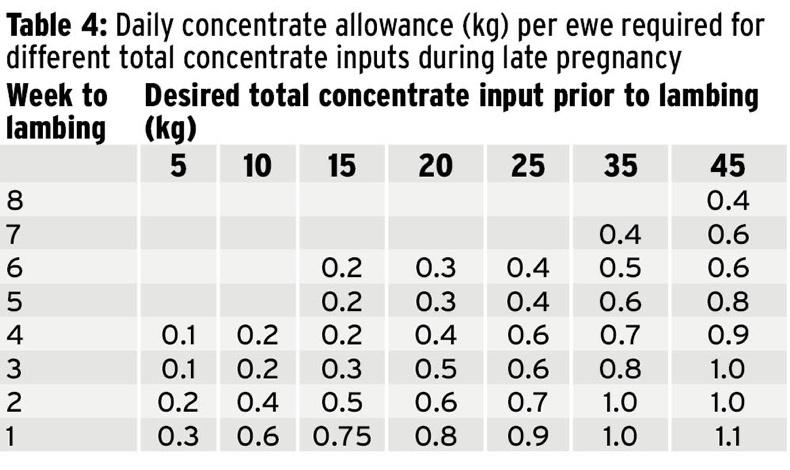
Due to the inclement weather conditions which prevailed in 2017 some producers who are short of forage, or have low feed-value forage, are considering high-concentrate systems for their ewes during late pregnancy.
A previous study at Athenry which evaluated high-concentrate and conventional silage-based diets during late pregnancy concluded that both type of diets produced lambs which had similar levels of performance.
When feeding high-concentrate diets the objective is to offer adequate quantities of concentrate to meet energy and protein requirements.
As litter size increases and lambing approaches concentrate feed level must increase.
Proposed concentrate feed levels for ewes during the final eight weeks of pregnancy are presented in Table 6. The data presented shows that ewes carrying singles, twins and triplets require 64kg, 74kg and 81kg concentrate respectively during the final eight weeks of pregnancy. To ensure the success of high-concentrate system during late pregnancy:
Ensure all ewes have adequate space to eat together.Build up concentrate feed level daily for the first week after housing and slowly reduce forage.Provide some roughage and ensure that all ewes can access it at the same time.Feed the concentrate twice daily to reduce the risk of acidosis.Provide a clean supply of water. Group the ewes according to expected lambing date. If the ewes are offered the high levels of concentrate specified for the week prior to expected lambing date for a number of weeks, more assistance (labour) is likely to be required at lambing due to over-sized lambs, potentially increasing mortality.Group according to expected litter size.Crude protein concentration can be reduced to 16%.Discuss with your concentrate supplier ingredient composition and potential mineral issues, eg copper.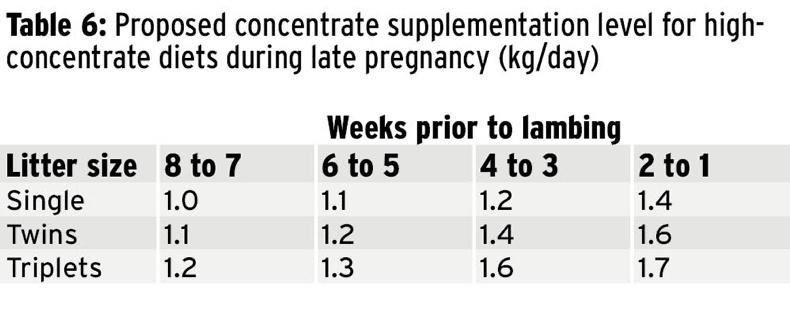
*Dr Tim Keady is principal research officer in sheep production at the Animal and Grassland Research and Innovation Centre, Teagasc, Athenry, Co Galway.
The level of supplementation offered to ewes in late pregnancy should be based on lambing date, forage quality and expected litter size.Each five percentage-point increase in silage DMD increases ewe weight post lambing by 6.5kg and increases lamb birth weight by 0.25kg. Minimise concentrate usage by penning ewes according to expected litter size and lambing date. When purchasing concentrate select on ingredient composition and not solely on price.With high feed value grass silage, it is better to feed concentrate than low levels of soya bean meal (5kg).High concentrate diets are an option but require good feeding management. Ensure ewes are grouped by expected litter size and expected lambing date. Read more
Sheep links
Sheep prices: steady but some plants circling
Strong demand for fleshed hoggets sees prices edge up slightly
Improved demand for well-fleshed lambs and ewes
Weather cuts lamb crop by up to 15%
Management of the ewe in late pregnancy affects lamb weight and vigour at birth, and colostrum production by the ewe, all of which influence labour requirement at lambing and flock profitability.
Each additional 0.1 lamb reared per ewe joined is worth approximately €10/ewe.
This article summarises results from the studies at Athenry on the effects of the type of nutrition offered to ewes in late pregnancy on ewe and lamb performance.
Digestibility (DMD) is the most important indicator of the feed value of grass silage when offered to ewes. At farm level, DMD of grass silages can vary from 52% to 82%; the average DMD of silage produced in Ireland is 70%.
Consequently, when developing a nutritional plan for housed ewes in late pregnancy it is essential to know the feed value of the silage being offered.
A number of studies were undertaken at Athenry to evaluate the effect of silage digestibility on the performance of pregnant ewes, and that of their progeny.
Increasing silage DMD increased ewe liveweight and body condition score (BCS) at lambing and increased lamb birth and weaning weights. Each five percentage-point increase in silage DMD increases ewe weight post-lambing by 6.5kg and lamb birth weight by 0.25kg.
An alternative way to evaluate silage feed value is to determine how much concentrate is required to yield lambs of a similar birth weight.
At Athenry, ewes offered a high feed value (high DMD) grass silage and supplemented with 5kg concentrate (soya bean meal plus minerals and vitamins) during late pregnancy produced lambs that were heavier than the lambs from equivalent ewes offered a medium feed value silage supplemented with 20kg concentrate.
Therefore, the high feed-value grass silage enabled concentrate supplementation to be reduced by at least 75 %.
Silage feed value and concentrate
The effects of concentrate feed level and silage feed value (DMD) on lamb birth weight and BCS at lambing are presented in Table 1.
Note for ewes offered silage with 70 % DMD, increasing concentrate feed level allowance above 25kg yielded no real gain in lamb birth weight but the ewes were clearly fatter (higher BCS); for ewes on 75% DMD silage – increasing concentrate allowances above 15kg yielded a minimum change in lamb birth weight.
Therefore, the increased energy intake from feeding excess concentrate to ewes during late pregnancy is converted to body fat.

Soya bean meal as the concentrate
Two studies have been undertaken at Athenry (Table 2) to evaluate the effects of replacing concentrate with low levels of soya bean meal (5kg) during late pregnancy in ewes offered high feed value grass silage. Increasing concentrate feed level from 15kg to 25kg during late pregnancy had little effect on lamb birth or weaning weight.
Reducing supplementation from 15kg concentrate to 5kg soya bean meal reduced lamb birth weight by 0.2kg, weaning weight by 0.8kg, and supplement cost by €1.45 but increased lamb age at slaughter by approximately one week, silage requirements by 9 % and silage cost by approximately €0.80.
The difference between reduced concentrate cost and increased silage cost is small. With high feed value grass silage it may be more prudent to offer concentrate during late pregnancy rather than supplement with lower levels of soya bean meal.

Level of concentrate to offer
The effects of silage feed value on the concentrate requirement of twin-bearing ewes in late pregnancy are presented in Table 5.
It is assumed that the silage is offered using good feeding management, ie ewes have access to fresh silage 24 hours daily and that any silage residue is removed twice weekly.
The main factor influencing concentrate requirement during late pregnancy is silage DMD. For example, for silages at 79% and 64% DMD an additional 3kg and 10kg concentrate, respectively are required for long-chop silages, compared with precision-chop-silages.
The concentrate requirements per ewe presented in Table 3 can be reduced by 5kg in the case of single-bearing ewes, while concentrate supplementation should be increased by 8kg for ewes carrying triplets.

Concentrate protein content
For prolific flocks, the concentrate should be formulated to contain 19% crude protein as the grass silage on many sheep farms has a low protein concentration.
Some personnel within the industry suggest formulating low and high protein concentrates for feeding to ewes during weeks six to four prior to lambing and weeks three to lambing, respectively.
However, considering the size of most sheep flocks in Ireland and the fact that ewes require low levels of concentrate during the first two to three weeks of supplementation, together with the low protein concentration of grass silage on most sheep farms the savings from using two different concentrates is, at best, marginal.
For example, while relative to a 19% crude protein concentrate, the cost of formulating a 14% crude protein concentrate is lower by approximately €25/t. This equates to only 0.5c and 1c per ewe daily when ewes are offered 0.2kg and 0.4kg/day during the first few weeks of supplementation.
For every 100 ewes in a flock one tonne of concentrate will last for 50 and 25 days, respectively, when ewes receive a daily concentrate allowance of 0.2kg and 0.4kg/head.
For most farms there is no benefit to animal production, logistics or financial outcome from offering a low protein concentrate during the first weeks of concentrate supplementation.

Protein source
The effects of concentrate protein source offered during late pregnancy on the performance of ewes and their progeny were evaluated at Athenry.
Two concentrates were formulated to have the same metabolisable energy and protein concentrations. The protein sources in the concentrates were either soya bean meal or a mixture of by-products (rapeseed, maize distillers and maize gluten).
Lambs born to ewes that had been offered the soya bean-based concentrate were 0.3kg and 0.9kg heavier at birth and weaning, respectively.
The increased weight of lambs at weaning from ewes offered the soyabean-based concentrate in late pregnancy (extra cost ~ €0.60/ewe) is similar to the response obtained from offering each lamb 6kg of creep concentrate until weaning (cost ~ €3.50/ewe per set of twins).
Therefore, it is more cost-effective to offer concentrate formulated with good ingredients (eg soya, cereals, pulps) to ewes in late pregnancy than supplement lambs to increase lamb weaning weight.
The ingredient composition of the concentrate that I formulated for ewes during late pregnancy at Athenry is presented in Table 5.
The concentrate was formulated to contain 19% protein using good protein (soya, rapeseed), energy (maize, barley) and fibre (beet pulp, soya hulls) sources.
Soya bean meal should form the main protein source for concentrates offered to ewes during late pregnancy.
When offering similar levels of concentrate to ewes during late pregnancy as is offered at Athenry, a reduction in concentrate price of €20/t equates to a saving equivalent of only 44c/ewe.
Therefore, when purchasing concentrate, it is very important to be aware of its ingredient composition rather than basing the decision on which concentrate to purchase solely on price alone.
Concentrate feeding management
To optimise the use of concentrate ewes should be grouped according to predicted litter size (based on ultrasonic scanning) and expected lambing date (mating date – raddle colour).
As lamb weight increases by 70% during the last six weeks of pregnancy, the demand for nutrients increases substantially. Consequently, supplementation should be stepped up weekly over the period immediately prior to lambing. The objective is to produce lambs at the optimum birth weight (that will not require assistance during delivery), and ewes with adequate supplies of colostrum.
The feed schedules required to deliver different concentrate feed levels, varying from 5kg to 45kg per ewe in late pregnancy, are given in Table 4.
During the week prior to lambing ewes receive up to 1kg daily, clearly illustrating the benefits of penning ewes according to expected lambing date, as well as expected litter size.
For example, for each extra week ewes are on the high level of concentrate supplementation they would consume 7 kg concentrate, dramatically increasing concentrate usage and cost (€2/ewe), and potential assistance (labour) required at lambing.

Due to the inclement weather conditions which prevailed in 2017 some producers who are short of forage, or have low feed-value forage, are considering high-concentrate systems for their ewes during late pregnancy.
A previous study at Athenry which evaluated high-concentrate and conventional silage-based diets during late pregnancy concluded that both type of diets produced lambs which had similar levels of performance.
When feeding high-concentrate diets the objective is to offer adequate quantities of concentrate to meet energy and protein requirements.
As litter size increases and lambing approaches concentrate feed level must increase.
Proposed concentrate feed levels for ewes during the final eight weeks of pregnancy are presented in Table 6. The data presented shows that ewes carrying singles, twins and triplets require 64kg, 74kg and 81kg concentrate respectively during the final eight weeks of pregnancy. To ensure the success of high-concentrate system during late pregnancy:
Ensure all ewes have adequate space to eat together.Build up concentrate feed level daily for the first week after housing and slowly reduce forage.Provide some roughage and ensure that all ewes can access it at the same time.Feed the concentrate twice daily to reduce the risk of acidosis.Provide a clean supply of water. Group the ewes according to expected lambing date. If the ewes are offered the high levels of concentrate specified for the week prior to expected lambing date for a number of weeks, more assistance (labour) is likely to be required at lambing due to over-sized lambs, potentially increasing mortality.Group according to expected litter size.Crude protein concentration can be reduced to 16%.Discuss with your concentrate supplier ingredient composition and potential mineral issues, eg copper.
*Dr Tim Keady is principal research officer in sheep production at the Animal and Grassland Research and Innovation Centre, Teagasc, Athenry, Co Galway.
The level of supplementation offered to ewes in late pregnancy should be based on lambing date, forage quality and expected litter size.Each five percentage-point increase in silage DMD increases ewe weight post lambing by 6.5kg and increases lamb birth weight by 0.25kg. Minimise concentrate usage by penning ewes according to expected litter size and lambing date. When purchasing concentrate select on ingredient composition and not solely on price.With high feed value grass silage, it is better to feed concentrate than low levels of soya bean meal (5kg).High concentrate diets are an option but require good feeding management. Ensure ewes are grouped by expected litter size and expected lambing date. Read more
Sheep links
Sheep prices: steady but some plants circling
Strong demand for fleshed hoggets sees prices edge up slightly
Improved demand for well-fleshed lambs and ewes
Weather cuts lamb crop by up to 15%







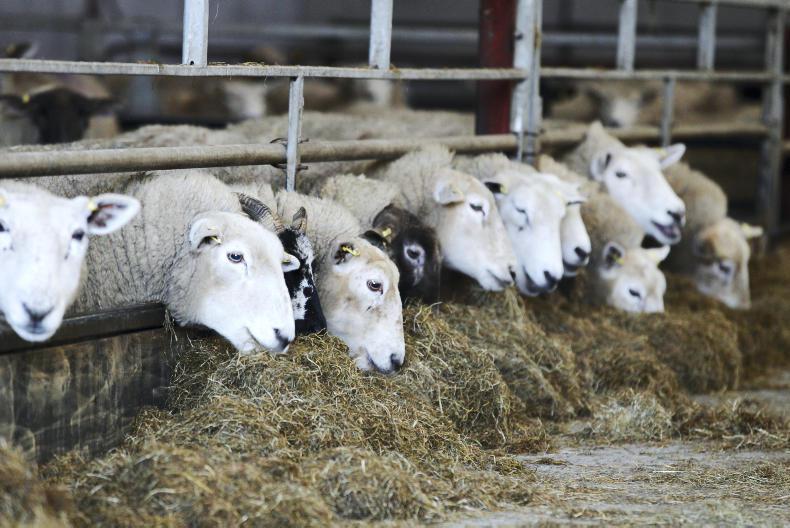




 This is a subscriber-only article
This is a subscriber-only article












SHARING OPTIONS: